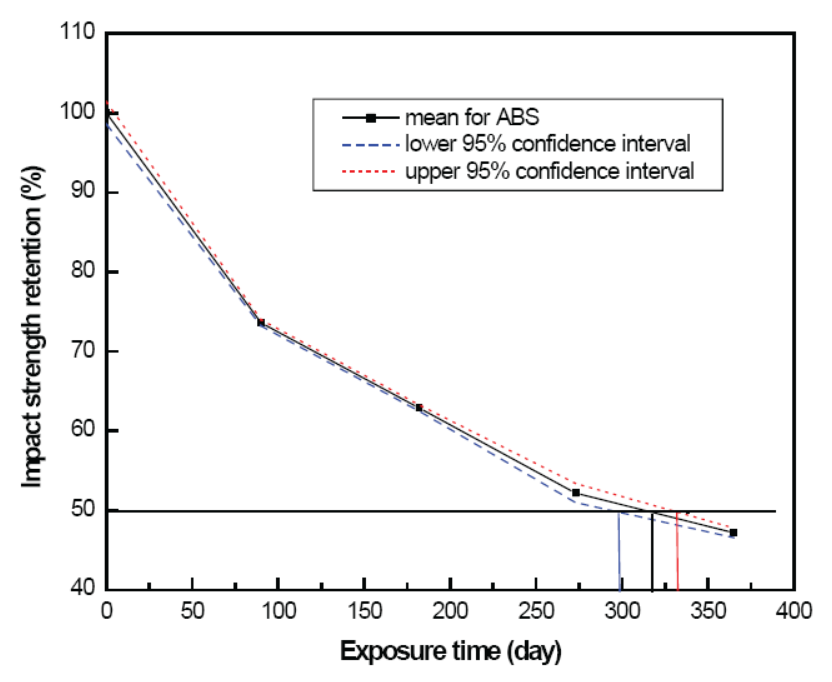A study of the effect of outdoor exposure on the impact strength of plastics
DOI:
https://doi.org/10.60136/bas.v1.2012.176Keywords:
impact strength, outdoor exposure, plastic, polycarbonate, poly(acrylonitrile-butadiene-styrene)Abstract
In this study, the changes in impact strength of two types of plastics due to natural outdoor exposure were investigated. Determinations of impact strength of the materials weathered at Bangkok, Thailand exposure site were performed every three months for a period of one year. It was found that each material had different patterns of the changes in their impact properties. Impact strength values of poly(acrylonitrile-butadiene-styrene) decreased highly in the first three months and the decreases were gradually slow down afterward. At 317 days of exposure time, impact strength retention was 50%. Polycarbonate, another type of plastic, had the decreases in impact strength values less than 10% of the original value during the first 6 months of the whole exposure time. When the exposure time approached 233 days, impact strength was close to 50% of its original value. Starting from the ninth month, impact strength was lost more than 80%. By using the information obtained in this study, poly(acrylonitrile-butadiene-styrene) could then be assessed as being a more durable material to outdoor environment exposure than polycarbonate.
References
International Organization for Standardization. Plastics-Method of exposure to direct weathering, to weathering using glass-filtered daylight, and to intensified weathering by daylight using Fresnel mirrors. ISO 877, 1994, p.1-15.
International Organization for Standardization. Plastics-Preparation test specimens by machining. ISO 2818, 1994, p. 1-10.
International Organization for Standardization. Plastics-Determining of Charpy impact properties-Part 1: Non-instrumented impact test. ISO 179-1, p. 1-17.
Wypych, George. Handbook of material weathering. 4th edition, Toronto : Chemtec Publishing, 2008, p.11.
Getlicherman, M., Trojan, M., Daro, A. and David, C. “Degradation of polymer blends. Part VI : photo-oxidation of polyethylene containing SIS triblock copolymers.” Polym. Degrad. Stab., 1993, 39, 55-68.
Gardette, J.L. "Heterogeneous photooxidation of solid polymers.“ Angew. Makromol. Chem., 1995, 232, 85-103.
Gardette, J.L., Mailhot, B. and Lemaire, J. “Photooxidation mechanism of styrenic polymers.” Polym.Degrad. Stab., 1995, 48(3), 457-470.
Piton, M. and Rivaton, A. “Photooxidation of ABS at long wavelengths (a>300 nm)." Polym. Degrad. Stab., 1997, 55(2), 147-157.
Factor, A. “Search for the sources of color in thermally aged, weathered and r-ray irradiated bisphenol A polycarbonate.“ Angew. Makromol. Chem., 1995, 232, 27-43.
Pratt, G.J. and Smith, M.J.A. “Ultraviolet degradation and stabilization in poly(dian carbonate): dielectric measurements-Il.” Polym. Degrad. Stab., 1997, 56(2),179-183.
Motyakin, M.V., Gerlock, J.L. and Schlick, S. “Electron spin resonance imaging of degradation and stabilization processes : Behavior of a hindered amine stabilizer in UV-exposed poly(acrylonitrile-butadiene-styrene) polymers." Macromolecules., 1999, 32(16), 5463-5467.
Belofsky, Harold. Plastics: Product design and process engineering. Ohio : Hanser/Gardner, 1995, p. 178-179.

Downloads
Published
How to Cite
Issue
Section
License
Copyright (c) 2012 Bulletin of Applied Sciences

This work is licensed under a Creative Commons Attribution-NonCommercial-NoDerivatives 4.0 International License.









